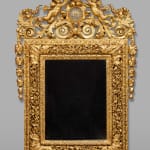Unknown
Literature
Graham Child, "The World of Mirrors 1650-1900", 1990, pl. 316, illustrating a similar but slightly earlier Louis XIV carved giltwood mirror (circa 1680-90; 55 cm high), again with an elaborate foliate pierced frame which is surmounted by a pair of putti who support a crown.
A rare and extremely fine quality Louis XIV carved giltwood mirror, the chamfered mirrored glass set within a rectangular frame elaborately carved with flowering roses offset at the angles by acanthus leaves with inner and outer foliate banding to include fruiting laurels, the whole surmounted by an intricate pierced crest enclosing scrolls and acanthus leaves with fruiting laurel leaf drops to either side, the top bar surmounted by a basket of roses and other flowers flanked by a pair of winged putti above a circular cartouche featuring entwined monogram lettering, possibly G M R
France, date circa 1710
Size to include frame: Height 159 cm, width 108 cm. Size of glass: Height 74 cm, width 54 cm.
This rare mirror is of outstanding quality. Not only is the elaborately carved frame with pierced cresting of outstanding beauty but the monogram on the crest indicates that it was made for an important client. Although their identity is not known the decorative elements within the overall design are inevitably related to them. A basket of flowers was generally used to symbolise Hope while roses, often associated with the Virgin Mary (a rose without thorns) were also used as a symbol of England and as well as love, as an attribute of Venus mythological goddess of love. Likewise the winged putti were usually associated with the theme of love and thus together imply that the mirror may have been made to mark a marriage, hence the entwined monogram. Other decorative elements include the laurel and acanthus, the latter being a familiar decoration of classical looking-glass frames and furniture as well as in all the decorative arts. Likewise the laurel was another popular decoration inspired by Antiquity but can also be used to denote victory since in ancient Greece and Rome they were used to make a victor's crown.
Taken as a whole the pierced leaf-carved frame reflects the knowledge that French craftsmen had of foreign craftsmen and frame-makers since similar carved frames were being made by the English and Dutch makers during the second half of the seventeenth century. By then Louis XIV's brother Philippe duc d'Orléans was taking an active interest in the French glass industry, for instance he was a patron of Jean Castello from Altare who with his nephew Bernard Perrot established a glass-works in Orléans. In 1688 Perrot invented a method of casting glass that made it possible to produce much larger and clearer panels of glass than those previously made by the old method of blowing glass.



